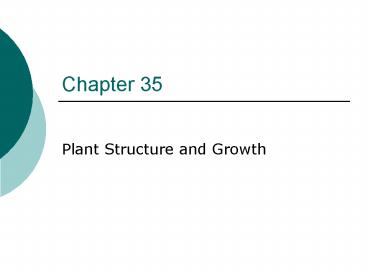Plant Structure and Growth - PowerPoint PPT Presentation
1 / 25
Title:
Plant Structure and Growth
Description:
Highly adaptable (more so than animals) to the environmental ... Two main groups of flowering plants. Monocots and Dicots. Roots, Stems, and Leaves. Root System ... – PowerPoint PPT presentation
Number of Views:33
Avg rating:3.0/5.0
Title: Plant Structure and Growth
1
Chapter 35
- Plant Structure and Growth
2
Structure of Angiosperms
- Highly adaptable (more so than animals) to the
environmental pressures they endure - Cacti has short condensed leaves to reduce
surface area - Cabomba species in the water has feathery leaves,
and broad leaves on the surface for floating
3
Three Basic Organs
- Two main groups of flowering plants
- Monocots and Dicots
- Roots, Stems, and Leaves
4
(No Transcript)
5
Root System
- Roots anchor the plant, absorb minerals and
water, and store food - Roots contain root hairs
- Increased surface area for absorption
- Adventitous roots
- Roots that grow above ground
- Cyprus knees
- Corn roots
6
Shoot System
- Stems and Leaves
- Consist of nodes (leaf bases) and internodes
(spaces of the stem between leaves) - Nodes contain axillary buds
- Which may form a vegetative branch (new stem)
- Terminal bud the growing portion of the stem tip
7
(No Transcript)
8
Shoot System Leaves
- Main photosynthetic unit of the plant
- Made up of a blade and petiole
9
Plant Organ Tissues
- Three tissue types
- Dermal epidermis
- Plant covering
- Vascular transport of materials between roots
and shoots - See vascular slide for details
- Ground - neither dermal or vascular
- Pith and cortex
- Responsible for photosynthesis
- Storage and support
10
(No Transcript)
11
Vascular Tissue
- Made up of Xylem and Phloem
- Xylem transports water and minerals from roots
to shoots - Phloem transports sugars to roots and
nonphotosynthetic portions of plant
12
Xylem
13
Phloem
14
Cell Types
- Each type of tissue is composed of the following
cell types - Parenchyma
- Thin cell walls
- Least specialized
- Perform most metabolic functions
- Do photosynthesis
- Non differentiated
15
Cell Types
- Collenchyma
- Thick cell walls
- Help support young parts of plant shoot
- Strings of celery stalk
- Alive at maturity
- Sclerenchyma
- Support
- Occur in non growing regions of a plant
- Die at functional maturity
- Tracheids are sclerenchyma
16
(No Transcript)
17
Plant Growth and Development
- Plants grow as long as they live
- Indeterminate growth
- Due to perpetually embryonic tissues called
meristems - Can become anything
- Apical meristems primary growth
- Lateral meristems secondary growth
- Only in woody plants
18
(No Transcript)
19
Primary Growth of Roots
20
Primary Tissues of Root
21
Primary Growth of Stems
22
Primary Tissue of Stems
23
Tissue Organization of Leaves
24
Secondary Growth of Stems
- The widening of the stem
- Common in dicots and gymnosperms
- Due to vascular cambium and cork cambium
25
Secondary Growth of Stem































